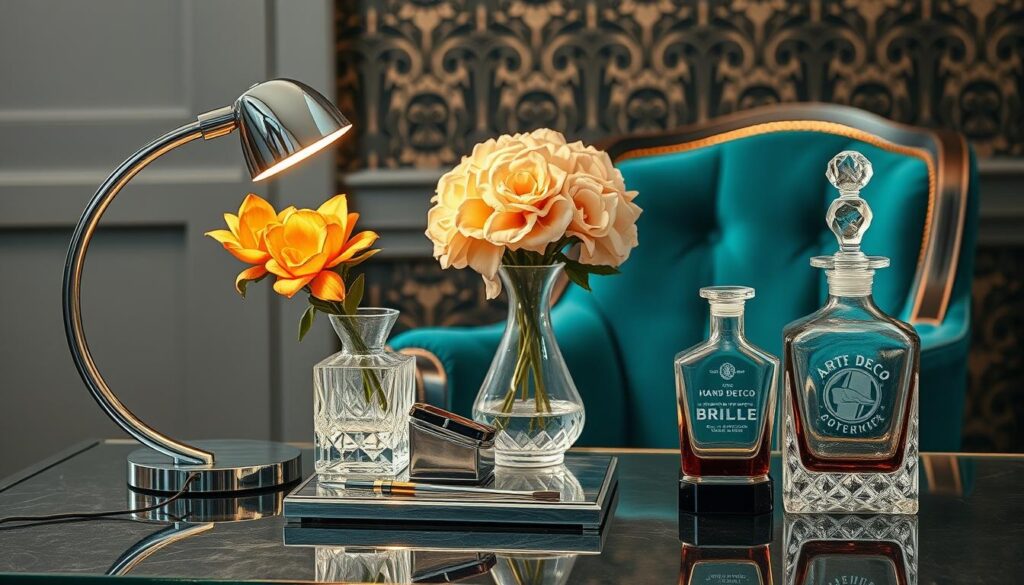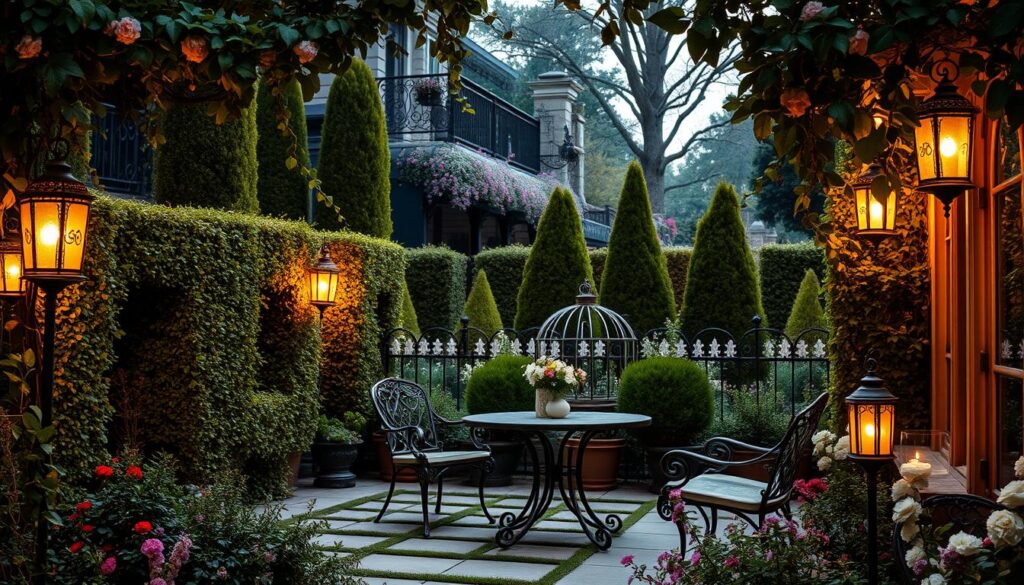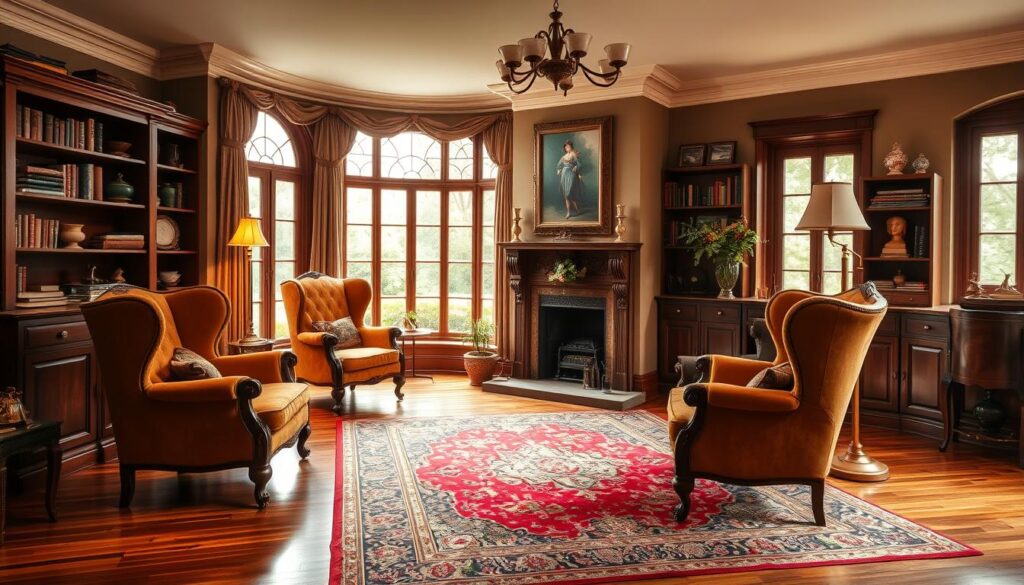The Roaring Twenties were a time of luxury and glamour. They still inspire us today with their vintage home décor. Did you know adding 1920s design to your home can make it look better and increase its value? We’re here to help you turn your home into a stylish 1920s retreat.
In this guide, we’ll show you how to bring the 1920s into your home. We’ll cover everything from lavish furnishings to intricate patterns. You’ll learn how to mix old and new to create a space that feels like the 1920s.
Key Takeaways
- Understand the core elements of 1920s design aesthetic.
- Learn how to incorporate vintage décor into your modern space.
- Discover the art of mixing vintage and contemporary pieces.
- Explore the role of luxurious materials in 1920s interiors.
- Get tips on creating a cohesive 1920s-inspired look.
Understanding the 1920s Design Aesthetic
The 1920s was a time of big change in interior design. Art Deco and other styles emerged. This era changed how people lived, worked, and decorated their homes. It showed the cultural and social shifts of the time.
Key Features of 1920s Home Interiors
Home interiors in the 1920s had bold colors and luxurious fabrics. Art Deco, with its geometric shapes and metallics, shaped the decade’s design trends.
Some key elements of 1920s home interiors include:
- Statement furniture with intricate designs
- Use of metallic materials like chrome and silver
- Geometric patterns and motifs
- Rich, bold color schemes
Influential Design Movements of the Era
The 1920s saw several design movements, with Art Deco leading the way. Hollywood Regency also made a big impact, bringing a glamorous and opulent look to home decor.
These movements showed the cultural and social dreams of the era. They still inspire interior design today. By understanding these styles, homeowners can add a touch of the 1920s to their homes, making them unique and captivating.
Color Schemes Inspired by the 1920s
The 1920s celebrated opulence, and their color schemes were no different. They featured rich jewel tones and metallic accents. These bold and vibrant colors still inspire retro home furnishings and 1920s home interiors today.
Popular Color Palettes
The 1920s were known for their extravagant color use. Some popular color palettes included:
- Rich jewel tones such as emeralds, sapphires, and rubies
- Metallic colors like gold, silver, and bronze
- Deep, muted neutrals that provided a sophisticated backdrop for bolder colors
These colors were often mixed to create a luxurious atmosphere. For example, pairing deep blues with gold accents added sophistication to any room.
| Color | Common Uses | Effect |
|---|---|---|
| Emerald Green | Accent walls, furniture upholstery | Luxurious, opulent |
| Gold | Metallic accents, lighting fixtures | Glamorous, sophisticated |
| Deep Blue | Walls, decorative accessories | Calming, elegant |
How to Use Bold Colors Effectively
Using bold colors effectively is key to capturing the essence of 1920s home interiors. Here are some tips:
- Create a statement wall: Use a bold, rich color on one wall to create a focal point in the room.
- Incorporate colorful textiles: Use vibrant fabrics for upholstery, curtains, and throw pillows to add depth and visual interest.
- Balance bold colors with neutrals: Pair bold colors with neutral backgrounds to avoid overwhelming the space.
By thoughtfully incorporating bold colors, you can bring the glamour of the 1920s into your home. Consider adding metallic accents or rich jewel tones to give your space a touch of retro flair.
Furniture Styles of the Roaring Twenties
The 1920s were a time of glamour and sophistication in furniture design. This era saw the rise of new styles and the evolution of old ones.
Iconic Styles: Art Deco and Beyond
Art Deco became popular in the 1920s. It featured geometric shapes, luxurious materials, and ornate decoration. Furniture from this era often had bold, metallic accents and exotic motifs.
Other notable styles of the era include:
- Modernism, with its clean lines and minimal ornamentation
- Traditional styles, such as neoclassicism, which continued to influence furniture design
- Exoticism, with furniture makers incorporating elements from international cultures into their designs
Selecting the Right Pieces for Your Space
When choosing furniture, think about the style and era you want to evoke. For a vintage look, find pieces that show the opulence of the 1920s. Look for ornate mirrors, grand pianos, and luxurious upholstery.
For a more subtle look, add antique home accessories. Consider vintage vases, decorative figurines, or antique clocks.
| Furniture Piece | Description | Style |
|---|---|---|
| Grand Piano | A statement piece that adds elegance and sophistication | Art Deco |
| Ornate Mirror | A decorative piece that adds a touch of glamour | Art Deco |
| Vintage Armchair | A comfortable and stylish seating option | Traditional |
By adding these furniture styles and pieces to your home, you can create a space that captures the glamour of the Roaring Twenties.
Textiles and Patterns in the 1920s
In the 1920s, home decor was all about luxury and bold patterns. This was the Roaring Twenties, a time of glamour and opulence. Textiles were key in creating this look.
Luxurious Fabrics of the Era
The 1920s loved luxurious fabrics like velvet, silk, and linen. These were used in furniture, drapes, and more. Velvet was a favorite for its soft, plush feel.
To add luxury to your home, try velvet furniture or silk drapes. They bring elegance to any room.
Incorporating Geometric Patterns into Decor
Geometric patterns were big in 1920s design, thanks to Art Deco. You’d see chevrons, hexagons, and triangles in textiles and wallpaper.
To add these patterns to your home, start with small items. Try throw pillows or a geometric vase. It’s a subtle way to bring in the 1920s vibe.
| Fabric | Common Uses | Characteristics |
|---|---|---|
| Velvet | Upholstery, Drapery | Luxurious feel, soft pile |
| Silk | Drapery, Upholstery | Smooth texture, lustrous appearance |
| Linen | Upholstery, Bedding | Natural texture, breathable |
Using luxurious fabrics and geometric patterns can make your home feel like the 1920s. It’s a way to create a sophisticated, retro space.
Lighting Fixtures That Define the Era
In the 1920s, lighting became an art form. Fixtures were both functional and decorative, showing the Roaring Twenties’ spirit. The right lighting can make a space feel glamorous and sophisticated.
Lighting from the 1920s was more than just light. It was a way to show off style and status. Chandeliers and sleek sconces were designed to impress.
Vintage Lighting Options to Consider
There are many vintage lighting options. Art Deco chandeliers are iconic, with geometric shapes and metallics. Sconces were also popular, with a minimalist look that fit the era’s modern style.
- Chandeliers with geometric patterns and metallic accents
- Sconces with minimalist designs and frosted glass shades
- Table lamps with ornate details and luxurious fabrics
For vintage lighting in modern homes, antique stores and estate sales are great. You can also find reproductions or pieces inspired by the era.
Tips for Creating Ambient Lighting
To create 1920s-style ambient lighting, think carefully. Use dimmer switches to adjust light levels. Layer lighting with overhead, table, and floor lamps for a cozy feel.
“The key to great lighting is layering. It’s not just about the fixture itself, but how it works with other elements in the room to create a cohesive look.” – Lighting Design Expert
| Lighting Type | Characteristics | 1920s Style Tips |
|---|---|---|
| Chandeliers | Ornate, geometric, metallic | Pair with dimmer switches for adjustable ambiance |
| Sconces | Minimalist, frosted glass | Use in hallways and entryways for a sleek look |
| Table Lamps | Ornate, luxurious fabrics | Place on side tables and consoles for warm pools of light |
By using vintage lighting fixtures and techniques, you can bring the 1920s into your home. This creates a space that’s both nostalgic and stylish.
Accessorizing with 1920s Flair
The 1920s style is more than just furniture. It’s about the accessories that bring character and charm. The right decorative items are key to capturing the Roaring Twenties vibe.
Art Deco Accessories for Modern Homes
Art Deco accessories are a big part of 1920s decor. They feature geometric shapes, metallic materials, and a sense of luxury. To add this style to your home, consider these items:
- Geometric-shaped vases that reflect the era’s love for bold geometry.
- Metallic decorative items like chrome or silver-plated figurines and ornaments.
- Vintage posters or prints that echo the glamour of the 1920s.
These accessories bring a touch of the 1920s to your home. They also add sophistication and elegance.

Where to Find Authentic 1920s Decor
Finding authentic 1920s decor is fun and rewarding. Here are some places to start:
- Antique stores that specialize in vintage items.
- Online marketplaces like eBay or Etsy, where you can find a wide range of vintage accessories.
- Estate sales or auctions, where you can often find original 1920s decor at competitive prices.
When shopping for authentic 1920s decor, check items carefully. Look for signs of age and authenticity.
As designer Dorothy Draper once said, “The key to a great room is in the accessories.” This is true for capturing the 1920s vibe in your home.
“The 1920s was an era of opulence and glamour, and the accessories of the time reflect this. From lavish fabrics to intricate metalwork, the decorative items of the era are a testament to the craftsmanship and style of the time.”
Wall Treatments and Finishes
Wall treatments are key to capturing the 1920s vibe in your home. The right finishes can make your space feel like it’s from the Roaring Twenties. This brings back the glamour and sophistication of that era.
Popular Wallpaper Designs from the 1920s
The 1920s were known for their bold and exotic wallpaper designs. Geometric patterns, metallic accents, and floral motifs were big hits. They added luxury to any room. To bring this trend into your home, look for wallpapers with:
- Geometric shapes, such as chevrons and hexagons
- Metallic foil or ink for a luxurious sheen
- Floral patterns with a vintage twist
Techniques for Restoring Vintage Walls
Restoring vintage walls needs patience and care. To keep your 1920s home’s historic charm, follow these steps:
- Assess the wall condition: Check for damage, mold, or old adhesive.
- Strip old wallpaper: Use a gentle steamer or removal solution to avoid damaging the underlying surface.
- Repair damaged plaster: Use a lime-based plaster to maintain authenticity.
By carefully restoring your vintage walls and using authentic wall treatments, you can add the opulence of the 1920s to your home.
Emphasizing Architectural Details
When renovating historic homes, highlighting architectural details is crucial. Features like crown molding, millwork, and trim add elegance and sophistication. They make a room feel more refined and polished.
Crown Molding and Millwork Ideas
Crown molding and millwork bring classic elegance to vintage homes. Here are some ideas for your renovation:
- Choose traditional materials like wood or plaster for authenticity.
- Design custom millwork that fits your home’s style.
- Match the molding and millwork to your room’s color scheme.
| Crown Molding Style | Description | Best Used In |
|---|---|---|
| Simple Profile | A minimalist design with clean lines. | Modern or minimalist rooms. |
| Ornate Profile | Intricately designed with detailed patterns. | Traditional or vintage-themed rooms. |
| Layered Profile | Multiple layers create a dimensional look. | Luxury or high-end homes. |
Reinforcing a Vintage Feel with Trim
Trim is key to a vintage look in your home. The right trim can enhance your home’s aesthetic and create a unified look.
Here are some ways to use trim effectively:
- Use chair rail trim to decorate walls.
- Include baseboard trim to cover the wall-floor joint.
- Add casings around doors and windows for a finished look.
By focusing on architectural details like crown molding, millwork, and trim, you can achieve a vintage look. This is perfect for historic home renovations.
Outdoor Spaces Reflecting the 1920s Style
The Roaring Twenties were all about grand indoor spaces and outdoor areas too. We’ll explore how to add 1920s glamour to our outdoor spaces. This includes designing a Gatsby-inspired area and using landscaping that feels like the era.
Designing a Gatsby-Inspired Outdoor Area
To make an outdoor space feel like the 1920s, use luxurious materials and eye-catching furniture. Luxurious fabrics like velvet and silk can make outdoor furniture feel fancy. Adding vintage accessories, like old planters and detailed metalwork, can also bring the era to life.

Choose furniture that shows off the Art Deco style, with its geometric shapes and shiny accents. A standout piece, like a vintage-style outdoor sofa or a fancy fountain, can be the heart of your Gatsby-inspired area.
Landscaping Concepts That Echo the Era
The 1920s were all about formal, neat gardens. For a similar look, try a garden with symmetrical shapes, tidy hedges, and a central feature like a statue or fountain.
- Use a mix of colorful flowers and greenery for texture.
- Make pathways from stone or brick.
- Add old garden furniture and decorations.
As
“The garden is a love song, a duet between a human being and Mother Nature.” – Jeff Cox
, our outdoor spaces can show off our style and nature’s beauty.
| Landscaping Element | 1920s Style Characteristic | Modern Implementation |
|---|---|---|
| Gardens | Formal, symmetrical designs | Use hedges and topiaries |
| Pathways | Made from stone or brick | Incorporate vintage-style lighting |
| Furniture | Vintage, ornate pieces | Choose pieces with Art Deco motifs |
Mixing these elements can make an outdoor space that looks like the 1920s. It also becomes a special place for chilling out and having fun.
Bringing in Vintage Appliances
Adding vintage appliances to your kitchen brings back the glamour of the 1920s. These appliances mix old charm with today’s needs. They create a look that honors the past while meeting modern standards.
1920s-Inspired Kitchen Details
To get a 1920s kitchen vibe, add antique home accessories and retro touches. Marble countertops, copper accents, and old-time lighting can match retro appliances. The goal is to mix old charm with today’s ease, making your kitchen both pretty and practical.
Some cool 1920s kitchen features include:
- Retro-style refrigerators and stoves
- Vintage-inspired sink designs
- Copper or brass hardware
- Marble or granite countertops
Benefits of Incorporating Retro Appliances
Retro appliances look great and have real benefits. They’re often made to save energy, which is good for the planet. Plus, they can make your kitchen stand out, adding its own special touch.
As
“The art of interior design is not just about aesthetics; it’s about creating a lifestyle.”
, using retro appliances can make your kitchen feel cozy and welcoming. It’s a place where family and friends love to gather.
When picking retro appliances, think about the look you want. Choose ones that fit your kitchen’s style. With the right mix of old charm and new tech, you can make a kitchen that’s truly yours.
Creating a Cohesive 1920s Look
Mixing the elegance of the 1920s with today’s style can make for a unique and eye-catching home. It’s important to know how to mix vintage pieces with modern decor.
Blending Vintage and Modern Elements
One big challenge in making a 1920s-inspired home is mixing old and new. Begin by picking a few standout vintage items, like an antique armchair or a vintage chandelier. Then, add modern furniture that captures the era’s style and elegance.
For example, pair a vintage sofa with a modern coffee table that has geometric patterns, like Art Deco. This combination adds depth and creates a striking contrast.
Establishing a Signature Style
To create a unique style in your 1920s-inspired home, choose a color scheme that shows off the era’s glamour. Rich jewel tones, metallics, and deep neutrals were common in 1920s homes. Using these colors in your decor can make your space sophisticated and elegant.
Also, add personal touches that show your personality and style. This could be vintage accessories, artwork, or unique decor items. These add a personal touch to your space.
By carefully mixing vintage and modern elements and setting a strong style, you can make a 1920s-inspired home that’s stylish and shows your personal taste.
Resources for Further Inspiration
If you love the luxury and style of the 1920s, there’s a lot to explore. Whether you’re fixing up an old house or adding art deco touches to your home, these resources will help a lot.
Exploring Literature on 1920s Design
Books and magazines are full of info on 1920s home design. They cover vintage decor and restoration, giving you a peek into the era’s famous styles. These resources can guide your design choices and help you make smart decisions for your project.
Connecting with Fellow Enthusiasts
Online groups and forums are great for meeting others who love historic homes and art deco. You can ask questions, share your story, and learn from others. It’s a chance to get advice and inspiration from people who understand your passion for the 1920s.


